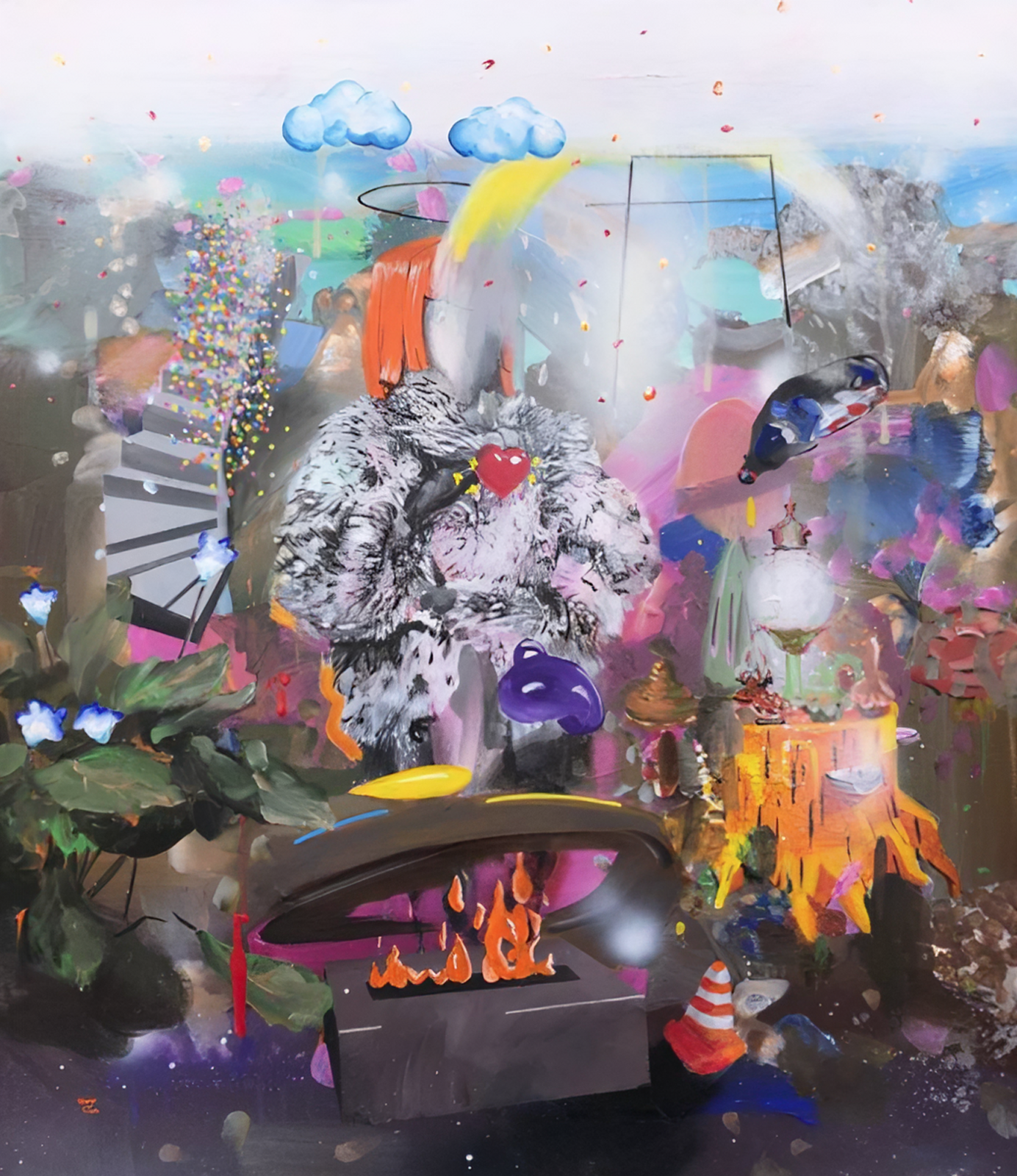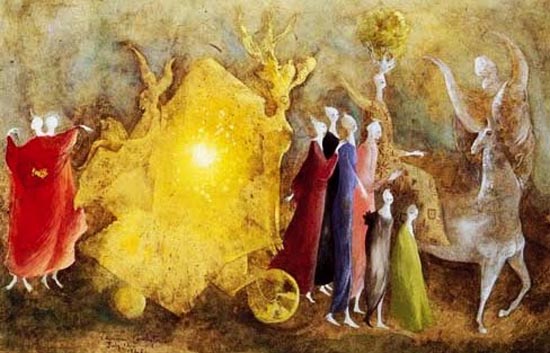“My works are earthly, starting with Junkyard Symphony, an approach related to the exterior, ground and waste. The space is increasingly populated by ordinary or current objects, but also by characters, I am trying to maintain a playful manner through representation and recomposition. It passes into another register, the interior, the desires, the lust. but keeping the same horizontal plane. So this is how the personal mythologies were born, with sincerity, boredom, suffering, desires, or guilty pleasures. Beginning with Toxic Desire, I’m more interested in distinguishing my subjectivity and individual development. All the works were shaped around personal experiences. From the representations of the bad choices we make through our superficiality and a hedonistic living, to the assumption of this flat existence. We are captive in a sort of limbo of desires. And on this realm I build my works, as a sequential reinterpretation of Hieronymus Bosch’s Garden of Earthly Delights.” –Edith Torony, “Love that Moves the Sun and Other Stars”, Saatchi Art, 2019
Leonora Carrington, “Amor che move il Sole et l’altre stelle” (1946)
“[T]he title of the painting above, Amor che move il sole l’altre stelle, comes from the Italian poet and father of the Italian language, Dante Alighieri. The painting is instead by British surrealist, Leonora Carrington.
“According to one interpretation of Dante’s Divine Comedy, love is the driving force behind everything. The universe and our planet. God was, without a doubt, Dante’s — and maybe Carrington’s — meaning of ultimate love. Thus, love is as powerful as a god, and love (as God) is the most powerful source of energy and everything else (and the other stars…). [. . .] –Jess the Avocado, “Love will Move the Sun and Other Stars,” Medium, May 24
View Amor che move and other paintings by Leonora Carrington here.
Read more about Carrington’s biography and how she “feminized surrealism” in The New Yorker.
GAU Dante, 2021
 “GAU-Gallerie d’arte Urbana è un progetto che ha come obiettivo quello di importare un modello di risanamento urbano che riesca, a ispirare bellezza e funzionalità, attraverso la street art, applicata ad un oggetto di uso quotidiano come le campane della raccolta differenziata del vetro. Il progetto ha come obiettivo principale quello di creare un galleria d’arte urbana gratuita, fruibile in ogni momento dal cittadino, per ribadire il concetto dell’arte come bene comune, incentivando l’attenzione sulle tematiche di differenziazione dei rifiuti.
“GAU-Gallerie d’arte Urbana è un progetto che ha come obiettivo quello di importare un modello di risanamento urbano che riesca, a ispirare bellezza e funzionalità, attraverso la street art, applicata ad un oggetto di uso quotidiano come le campane della raccolta differenziata del vetro. Il progetto ha come obiettivo principale quello di creare un galleria d’arte urbana gratuita, fruibile in ogni momento dal cittadino, per ribadire il concetto dell’arte come bene comune, incentivando l’attenzione sulle tematiche di differenziazione dei rifiuti.
“Per la sua quinta edizione, GAU sceglie di omaggiare Dante Alighieri nel settimo centenario della sua morte. Gli artisti lavoreranno sui 34 canti dell’Inferno, attualizzandoli attraverso la peculiarità del proprio linguaggio artistico, reinterpretando simboli, luoghi e personaggi della Divina Commedia in chiave contemporanea.
“Moby Dick – Giusy Guerriero – Dez – Marta Quercioli – Zara Kiafar – Tito – Violetta Carpino – Kiddo – DesX – Yest – Er Pinto – Olives – Lola Poleggi – Kenji – BloodPurple – Orgh – Lady Nina – Teddy Killer – Valerio Paolucci – Wuarky – Karma Factory – Muges147 – Maudit – Hoek – Alessandra Carloni – Cipstrega – Molecole – Korvo – Alekos Reize – Gojo.” —Gallerie d’Arte Urbana
See a gallery of all 34 decorated recycling bins, one for each canto of the Inferno, on the GAU website. You can also download the magazine on the site, which includes a map where visitors to Rome can locate each bin.
The image above features Korvo’s design for cantos 30-31. Photo credit Valentino Bonacquisti.
Commedia-Inspired Renaissance Paintings?
This review was written in reference to Martin Kemp’s examinations of John Took’s Dante. For more analysis, read the full article here.
“Kemp’s idea is to set up a paragone, comparing, on the one hand, Dante’s scientific and metaphorical/theological understanding of light and sight in the Divine Comedy (1308–21), especially in Paradiso, to, on the other, renderings of divine light in Italian Renaissance and Baroque painting. He opens with a scholarly survey of late medieval natural science accounts of optics and of light (noting in particular the widely accepted theories of the late 10th-/early 11th-century mathematician Ibn al-Haytham, known as Alhazan), before laying out what he understands of Dante’s knowledge of, and interest in, this topic, which he terms the poet’s ‘dazzle’—the failure of sight when confronted with the splendore (blinding light) of Empyrean Heaven.
[. . .] “Kemp makes periodic disclaimers throughout the book that it is impossible to cite documented or obvious connections between Dante’s light and works of art (except for illuminated or illustrated editions of the Commedia) but, to avoid cutting the ground from under his own feet, he makes a Roger-Fry swerve: the viewer will need a special sensitivity to see the ‘Dantesque’ as Kemp does. ‘The more general and less discernible diaspora [of Dante’s divine light] is something that can be sensed as a common factor as we pass from one scheme of decoration to another. This is not a matter of firm historical demonstration so much as the deployment of visual and poetic instinct.’ Kemp is insistent, pounding away with Maslow’s hammer throughout, that it is Dante’s divine light that appears in all the works he cites. It must be said that, in the paragone he proposes, it is not a question of attributable sources that is the problem; it is the category failure of comparing poetry with painting, apples with pears. Ultimately, Dante himself says that the only possible answer to ‘Who does divine light best?’ has to be God Himself, lux eterna.” –Donald Lee, The Art Newspaper, July 2, 2021
Paolo & Francesca paintings by Derek Overfield (2020)
“Immortalized by Dante’s Inferno and Rodin’s, The Kiss, the historical couple of Paolo and Francesca have moved audiences for over 700 years. The young couple fell in love while reading the romance of Lancelot and Guinevere, but their affair was cut short in tragedy. This collection contains 3 paintings, the first of the couple embracing. The second and third capture a moment – perhaps before their embrace, perhaps following their discovery. Twelve preparatory drawings in charcoal also accompany the painting of the embracing couple.” –from the portfolio of Derek Overfield
For more information about Derek Overfield and their work, view their portfolio here.
- « Previous Page
- 1
- 2
- 3
- 4
- …
- 8
- Next Page »




